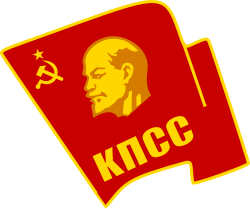Communist Party of the Soviet Union
The Communist Party of the Soviet Union (CPSU) was the ruling political party in the Soviet Union, and the only legal one. The leaders of the party were Vladimir Ilyich Lenin, Joseph Stalin, Lavrentiy Beria, Georgy Malenkov, Nikita Khrushchev, Leonid Brezhnev, Yuri Andropov, Konstantin Chernenko, and finally Mikhail Gorbachev.
Коммунистическая Партия Советского Союза | |
|---|---|
 | |
| General Secretary | Yelena Stasova (first; Apr 1917–1918) Mikhail Gorbachev (last; Mar 1985–Aug 1991) |
| Preceded by | Bolshevik faction of the RSDLP |
| Succeeded by | CPRF |
| Headquarters | Moscow, Staraya Square, 4 |
| Newspaper | Pravda |
| Youth wing | Young Communist League and Pioneers |
| Membership | 19 million (1986) |
| Ideology | Communism Marxism–Leninism (since 1929) |
| Political position | Extreme left |
| Religion | Atheism |
| International affiliation | Second International (1912–14)[1] Comintern (1919–43) Cominform (1947–56) |
| Colours | Red |
| Slogan | "Пролетарии всех стран, соединяйтесь!" ("Workers of the world, unite!") |
| Anthem | ("The Internationale") ("Hymn of the Bolshevik Party") (unofficial, 1939–52) |
Before the creation of the Russian Communist Party in 1918, its members were part of the Russian Social Democratic Labour Party. They made up a group within that party, which was called the Bolsheviks. The first leader of the CPSU was Vladimir Lenin. The first General Secretary of the party was Stalin from 1922–52. The party led the 1917 October Revolution that overthrew the Russian Provisional Government during World War I. From 1918–25, the name of the party was Russian Communist Party. From 1925–52, the name was All-Union Communist Party. The Party took the name Communist Party of the Soviet Union in 1952.
The Communist Party controlled all the government in the Soviet Union. The party supported communist movements in Eastern Europe, Asia and Africa. In 1990, during a big reform called "perestroika", or "restructuring", the party lost its position as the only party allowed. The CPSU was dissolved in 1991, and continued as the Communist Party of the Russian Federation. The new CPRF has sometimes been the largest in the Russian parliament, the State Duma.
Communist Party Of The Soviet Union Media
A neighborhood in the Kozhukhovsky Bay of the Moskva River with a large sign promoting the Communist Party of the Soviet Union, Moscow, 1975
The Brezhnev era is commonly referred to by historians as the Era of Stagnation, a term coined by CPSU General Secretary Gorbachev.[2]
Mikhail Gorbachev, the last leader of the CPSU and the Soviet Union, as seen in 1986
A Politburo resolution to execute 346 "enemies of the CPSU and Soviet Power" who led "counter-revolutionary, right-Trotskyite, plotting and spying activities" (signed by Stalin)
Stalinism, while not an ideology per se, refers to the thoughts and policies of Stalin.
References
- ↑ "2nd International Congress of Brussels, 1891". www.marxists.org.
- ↑ Hanson 2006, pp. 292–296.
Other websites
![]() Media related to Communist Party of the Soviet Union at Wikimedia Commons
Media related to Communist Party of the Soviet Union at Wikimedia Commons





